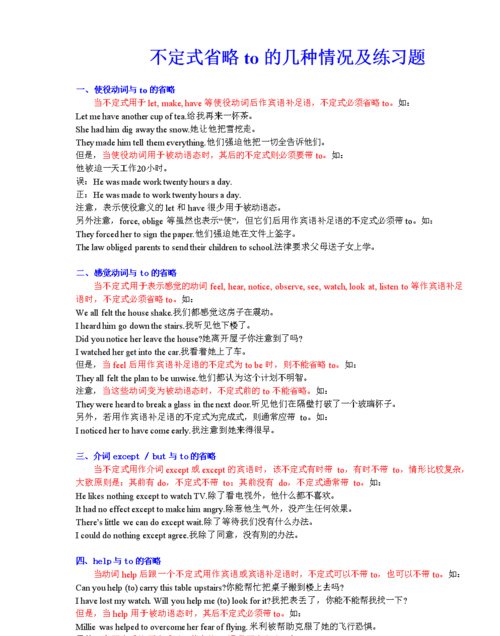本文目录
哪些动词不定式省略to顺口溜
动词不定式省略to的情况:
(1)不定式在感观动词(see,
notice,
look
at,
listen
to,
hear,
watch,
feel,
observe)、使役动词(let,
make,
have)后作宾语补足语时,通常省去to。如:
I
have
my
students
come
early.
(2)不定式在help后作宾补时,可带to,也可省略to。如:
I
helped
him(to)find
his
lost
watch.
注意:以上两种情况变成被动语态时要加上to。如:
She
was
seen
to
go
into
the
classroom.
(3)如果两个或多个不定式并列使用时,常在第一个不定式前面加to,后面一般都省略。如:
To
try
and
fail
is
better
than
not
to
try
at
all.
6.
“疑问词+不定式”组成的不定式短语在句中可以作主语、宾语和表语。如:
She
told
me
when
to
start.
参考资料:
***/101Resource006/wenjianku/200526/101ktb/JDE0126.htm

不定式省略to的固定搭配口诀
1、使役动词后省略to的情况,在let,make,have等使役动词后用作宾语补足语的不定式必须省略to。
2、当使役动词用于被动语态时,要补上在主动语态中省略的to(主要是指make,let和have很少用于被动语态)。
3、force,oblige等虽然也表示“使”,但它们后用作宾语补足语的不定式必须带to。
4、感觉动词后省略to的情况,在感觉动词后用作宾语补足语的不定式必须省略to。这里所说的感觉动词主要包括see,hear,observe,notice,feel,watch等。
但是它们用于被动语态时,其后的不定式必须带to。但是用于以上句型的动词notice和watch通常不用于被动语态。

扩展资料
to用法介绍
to可以是介词,也可以是结构助词。作介词用的时候,后面跟名词或动名词,作结构助词用的时候,是做不定式,后面必须跟动词原形等用法。
一般来说to有三种基本用法:
1、作介词,表示“到,向,往”,如go to,fly to后面跟名词作定语,构成介宾结构。
2、动词不定式的标志很常见的,如:want to do,be happy to do。注意有一些看似不定式但实为介词的结构,如look forward to,pay attention to,它们后面跟动词的ing形式作宾语,千万不能跟原形。
3、其他的如to+do作定语等等基本都是以上两种用法的延伸。
不定式符号to的省略和保留
动词不定式中的省略现象
动词不定式中的省略现象可分为两种情况,一是动词不定式符号to后的动词部分的省略;二是动词不定式符号to的省略.
一,省略动词不定式符号to后的动词部分的情况
1.一些表示心理活动,情感态度的动词或短语,如expect \want \hope \wish \love \hate \decide \plan \mean \try \would like \be ready \be afraid \be glad等后,动词不定式省略to后面的动词部分,但保留to.例如:
(1)-I 'll be away on a business trip.Would you mind looking after my dog
-Not at all .I'd be glad to.
(2)-Will you go with me
-Well ,I 'd like to.
(3)-Will you go home tomorrow
-No.I 'm going to a lecture,or at least I am planning to.
2.不定式作宾语补足语时,省略to后的动词部分,即用to代替整个不定式.例如:
(1)The boy wanted to ride his bicycle in the street but his mother told him not to.
(2)You'd better finish the job on time if he ordered you to.
3.在一些情态动词或助动词ought to \have to \used to \be able to后.例如:
(1)-Must I go now
-No.You don 't have to.
(2)-Are you planning to see your grandfather
-No.But I ought to.
二,省略动词不定式符号to的情况
1.动词不定式作感官动词feel \see \notice \watch \find \hear \listen to \observe和使役动词have \make \let等的宾语补足语时,动词不定式符号to省略.如果这些动词用于被动语态,其后的动词不定式符号to不能省略(但let除外).例如:
(1)We often hear him sing the song at home .
(=He is often heard to sing the song at home.)
(2)The y knew her very well.They had seen her grow up from childhood.
(=They knew her very well.She was seen to grow up from childhood.)
注意:
get作"使,让,叫某人做某事"时,要用get sb. to do s t h.结构.例如:
Mother got Tom to buy a pack of sugar.
2.两个或两个以上的动词不定式由连词and \or \than \but连接时,从第二个不定式起,往往省略不定式符号to.但如果强调对比之意时不省略.例如:
(1)She 'd like to take off her coat and have a break.
(2)The students are taught to read,write and do many other things.
(3)I t 's more difficult to do than to say .(强调语意前后对比)
(4)The teacher came not to punish you but to help you.(强调语意前后对比)
(5)I wondered whether to study or to work.(强调语意前后对比)
3.不定式作表语,用来解释主语或主语从句中do的精确含义时,往往可以省略动词不定式符号to.例如:
(1)The first things he did was go up to her trainer and thank her for all her help during her training.
(2)What we want to do now is lie down and rest.
(3)What a dictionary does is help the students to find out the meaning and the usage of new words .
4.在why或why not引起的表示建议或责问的省略问句中.例如:
(1)Why get so excited
(2)Why quarrel with your mother
(3)Why not join us,Tom
5.在一些类似情态动词词组had better \would rather \had best \rather than \can't but \can't help but等之后.例如:
(1)In China it is important to invest in education rather than increase personal wages.
(2)Jack would rather read than talk.
(3)You'd better put on more clothes,or you'll catch a bad cold.
(4)She dares to go to the lonely island by herself.I can 't but admire her bravery.
6.在美国口语中,用在祈使语气中表示目的的动词come \go \try \run之后的动词不定式符号to可省略,也可不省略.例如:
(1)Come tell me if he arrives.
(2)Go tell your mot her.
(3)Run swim together.
(4)Try open the door again.
(5)Try to open the door again.(不省略语气更强烈)
7.在一些固定短语中,
make believe(假装)
make do(凑合,设法对付)
let slip(说出)
leave go(放手)
hear say(听说)
let pass(忽略)
let be(别打扰).例如:
(1)The teacher didn 't let slip a word to us about the coming exam.
(2)I 've heard say that Mary was about to come .
(3)The boy made believe that he was reading when his father entered .
(4)Let him be.
(5)Don 't leave go(of)the fish.
另外值得注意的几种情况:
1.need作行为动词时,后面接带to的动词不定式;当dare作情态动词时,一般不用于肯定陈述句中;当dare作行为动词时,其后既可接带to的动词不定式,也可接不带to的动词不定式.例如:
(1)I dare to swim across the river.
(2)He dares to say that to his father.
(3)She doesn 't dare(to)answer her teacher 's question.
(4)We need to finish the job before lunch.
2.关于动词help后接动词不定式的问题:一般说来,help后既可接带to的动词不定式,也可接不带to的动词不定式(在美国英语及非正式文体中多见不带to).例如:
(1)Would you like to help me(to)carry the luggage
(2)Help the baby(to)get up,Susan!
3.but \besides \except作介词,后接动词不定式的情况:如果这些介词之前有行为动词do的各种形式,那么这些介词后的不定式不带to,反之则要带to.例如:
(1)She could do nothing but cry .
(2)What do you like to do besides swim
(3)He has no choice but to leave.
4.当like或want在由when \whenever \what \whatever \as \if等引导的状语从句中时,其后往往省略整个动词不定式.例如:
(1)Come whenever you like .
(2)Tom,don 't be nervous.
Take whatever you want!
(3)Do anything as you like.
(4)You don 't have to come swimming if you don 't want.

不定式作结果状语的几种情况
1. 在感觉动词后用作宾语补足语的不定式必须省略to。如:I watched her get into the car. 我看着她上了车。I saw the woman enter a bank. 我看见这个女人进了一家银行。We often hear her sing this song. 我们经常听到她唱这首歌。 Did you notice her leave the house? 她离开屋子你注意到了吗?注意:1)这里所说的感觉动词主要包括see, hear, observe, notice, feel, watch等。但是它们用于被动语态时,其后的不定式必须带to。如:The woman was seen to enter a bank. 有人看见这个女人进了一家银行。但是,用于以上句型的动词notice 和watch和通常不用于被动语态。2)类似地,动词look at和listen to后用作宾语补足语的不定式也不带to。如:We listened to the old man tell his story. 我们听这位老人讲述他的经历。3) 若动词feel后用作宾语补足语的不定式为 to be,则要带 to(其他情况不带 to)。如:They felt the plan to be unwise. 他们认为这个计划不明智。4) 若不定式为完成式,通常应带 to。如:I noticed her to have come early. 我注意到她来得很早。2. 使役动词后省略to的情况在let, make, have等使役动词后用作宾语补足语的不定式必须省略to。如:My mother wouldn’t let me go to the film. 我妈妈不会让我去看电影的。I don’t like milk, but mother made me drink it. 我不喜欢牛奶,可是母亲强迫我喝。I would have him wait for me at the gate of the park. 我要他在公园门口等我。注意:1) 当使役动词用于被动语态时,要补上在主动语态中省略的to(主要是指make,let和have很少用于被动语态)。2) force, oblige等虽然也表示“使”,但它们后用作宾语补足语的不定式必须带to。如:He forced me to go with them. 他迫使我同他们一起去。The police obliged him to leave. 警方强迫他离开。 二、主语带do表语省略to的情况由 all, what 引导的主语从句或者主语被only, first, one, least 或形容词最高级修饰时而且从句中含有do时,其表语如果是动词不定式,则往往省to。如:All you do now is (to) complete the form. 你现在要做的只是把这张表填好。The only thing to do now is (to) go on. 前进是现在唯一的出路。What I’ll do is 我要做的就是告诉她真相。 三、并列不定式省略to的情况由并列连词and,except, but, than, or 连接两个以上的具有相同意义或功能的不定式时,第二个动词不定式不带to。如:He told me to stay there and wait for him. 他叫我在那儿等他。I’m really puzzled what to think or say. 我真不知该怎么想怎么说。It is easier to persuade people than (to) force them. 说服人容易,强迫人难。注意:如果两个不定式表示对照或对比,则不能省略to。如:To try and fail is better than not to try at all. 尝试而失败总比不尝试好。四、动词help后省略to的情况在动词help后用作宾语或宾语补足语的不定式可以不带to。如:Can I help (to) carry this heavy box? 我可以帮忙扛这个重箱子吗?Mother helped me (to) do my homework. 妈妈帮助我做作业。注意:1. 当 help 之后接一个较长的名词词组作宾语或当其中的不定式所表示的动作主语不直接参加时,不定式通常带to。如:Help the little boys at the back of the hall to carry the chairs out. 请帮大厅后面那些小男孩把椅子搬出去。These tablets will help you to sleep. 这些药片将对你的睡眠有帮助。2. 在当help用于被动语态时,不定式前的to不能省略。如: The boy was helped by a woman to collect his scattered coins. 那男孩由一个妇女帮他捡拾散乱一地的钱币。 六、动词know后省略to的情况在宾语+不定式”中,不定式有时省略to,有时不省,可分以下两种情况讨论:1. 若 know 为现在式,该结构中的不定式只限于 to be,且其中的to,且其中的不能省略.如:I know him to be ill. 我知道他病了。We knew her to be honest. 我们知道她是诚实的。2. 若know为完成式或过去式,则该结构中的不定式可以用除 to be外的其他动词,且此时其中的to可以省留。如:I never knew him (to) do such a thing. 我从未听说他会干那种事。We’ve never known him (to) tell a lie. 我们从未听说他撒过谎。I’ve never known it (to) snow in July before. 我从未听说过有七月下雪的事。但在被动语态中不定式前的to不能省略。这样用的know不仅仅表示一般意义的“知道”,而是表示一种经历,因此常译为“曾……过”(用于肯定句时)用于肯定句时或“(从来)没有……过”(用于否定句时)。 七、介词except / but后省略to的情况用作介词except, but宾语的不定式有时带to,有时不带to。其大致原则是:若其前出现了动词 do,其后的不定式通常不带 to;若其前没有出现动词 do,则其后的不定式通常带 to。如:I had no choice but to wait. 除了等,我没有别的选择。He wanted nothing but to stay there. 他只想留在那儿。It had no effect except to make him angry. 除惹他生气外,没产生任何效果。She can do everything except cook. 除了做饭之外她什么都会。 八、省略不定式是否保留to在一定的上下文中,为了避免重复,有时不定式可以省略,但通常保留不定式符号to。如:I shall go if I want to. 如果我想去就去。“Don’t be late.”“I’ll try not to.”“不要来晚了。”“我尽量不来晚。”Don’t go till I tell you to. 等我叫你走你再走。注意:1. 若被省略的不定式为to be短语,则通常应保留to be。如:He is not the man he used to be. 他已不是原来的那个样子了。2. 有时省略不定式时,同时也可省略to。

以上就是关于不定式的省略保留to ,哪些动词不定式省略to顺口溜的全部内容,以及不定式的省略保留to 的相关内容,希望能够帮到您。
